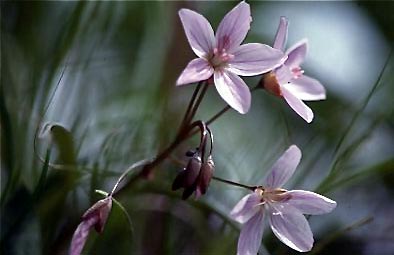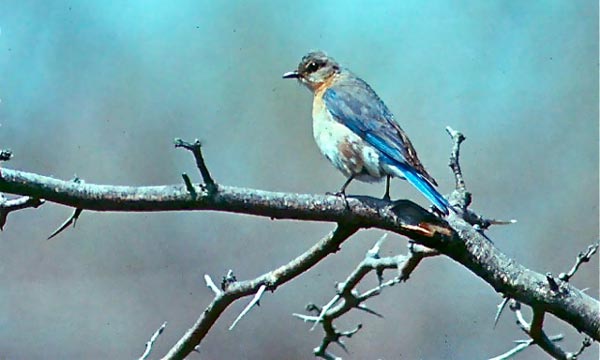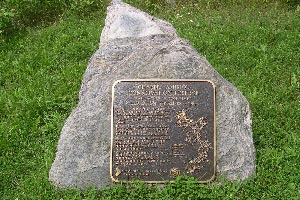Wilderness jewel Valley of the Don
Donald McClure | Feb 01, 2011 | Comments 4
Somewhere in the labyrinth of storage boxes that remain unopened and undiscovered for two decades, is a photograph of me holding a young snowy owl on a stick under a birch tree. The picture was taken by my friend Irwin Ledlie and a few feet above him, looking down, was the mother bird, quite calm despite our transgressions.
The time was 1946 and we were standing in a field on an escarpment above the Don River, about 300 yards east of the old Thorncliffe Race Track. We exchanged our hold on the stick and I photographed Irwin, with the baby owl’s big, baleful eyes staring into the camera. When we completed our posturing we held the stick up to the highest branch we could reach and coaxed the owl to release it’s grasp and find a safer perch. The mother never moved until we were out of sight.
Irwin whistled for Sandy his lithe, inseparable part-Kentucky Red bone hound and we headed back down the slope to cross the Don River and walk the 12 blocks between us and supper at our homes on Woodycrest Avenue.
For over five years Irwin and I walked the same route to adventure, sometimes over the Leaside Bridge, sometimes down Don Mills Road, always in the company of the wonder dog Sandy. We didn’t realize it at the time but we were among the privileged generation that could step back from an urban setting and into a virtual wilderness awaiting us a half hour’s walk away. And what a wilderness paradise it was.
Perhaps only a few people knew the landscape as well as we did in those days. The writer-naturalist Ernest Thompson Seton, did for sure. And Charles Souriol the author of Trails of the Don knew it better than anyone because he owned a cottage close to the river.
What people have forgotten of course is that at one time the Don Valley and its branches was one of the biggest bird migration sites in the province. In the 50s civic authorities and developers pictured the area as a vital transporation route to link expanding suburbia with the downtown. A great gouge was carved out of the Valley and the pavement laid for the Don Valley Expressway – the one we see every morning and evening on tv – jam-packed with vehicles.
Our wilderness paradise was lost forever, the Thorncliffe race track demolished to be replaced by massive apartment buildings, and all of the infrastructure of a modern community. We almost lost one of the greatest natural assets ever bequeathed to a city by its pioneering forbears. Almost but not quite,
It could have been worse. Through the efforts of caring people like Mr. Souriol a good bit of the valley system has been preserved and saved and linked up for public use and recreation. And today thanks to the efforts of conservation minded people it still offers an inviting system of foot and bike paths to enjoy a stroll in a cultivated natural setting.
But it’s not the same. For us in the 40s and 50s it was a time to discover the spring wildflowers that carpeted the hill sides – particularly drifts of trilliums. There were patches of violets, spring beauties and adder tongues also. As the hillsides turned green along the slopes we saw hundreds of warblers and spring migrants of all kinds darting through the maples and hawthornes. Later there were hidden wetlands full of red winged blackbirds, king birds, with meadowlarks and bobolinks in the open pastures. All year there were plump pheasants in the reeds and fields, ruffed grouse on the hillsides and in the cedar swaps, and drifts of black ducks up and down the river.

You can still search for wildflowers like Spring Beauties in the Don Valley - but they are scarce these days.
To be able to lose yourself in woods or wetlands along the Valley was a rare joy. And every now and then there were unusual trees that had survived earlier pioneer harvesting including giant basswood, white and golden birch, beech trees, red oaks and of course maples – all of which contributed their spring coolness and fall colour to the environment.
Often we would delay our walk home past the supper hour and listen to the chorus of Whip-poor-wills, along the hillsides and once even the tremolo of a screech owl echoing across the valley. Right here on the edge of the city were deer and foxes and we even found the tracks of a grey wolf .
One magical evening as we walked home over the bridge, Irwin looked up and stared into the sky. “Look up quick” he said. Up, up almost out of sight we saw a soaring mass of birds circling and drifting. The line stretched like a heavenly highway as far as you could see north and south. The next day Irwin brought a clipping from the Globe and Mail with a front page report that staff at the Royal Ontario Museum had witnessed a migration flight of an estimated 50,000 broad winged hawks the evening before over the Valley.
On another Saturday we sat beside a hawthorne tree eating our lunch watching a tiny owl staring at us a few feet away. We thumbed through our ancient birding book to identify it and decided it was a Richardson’s Owl (now called a Boreal Owl). For us it was an exciting discovery.
So many adventures; so much to recall; so fortunate to be there when it all existed. So pleased that some essence of it was protected and saved. So sad that too few people experienced it when it was in its glory.
Filed Under: Donald McClure • Uncategorized
About the Author: He can tickle your funny bone or tug at your heart strings. County people may know him as a chronicler of everything that happens (or should happen) in the garden, but his interests stretch across the natural world. His unique sense of observation takes in a wide expanse of living and may even point out some truths about our own condition as managers of the world around us. With Loyalist antecedents in his family tree his roots go deep into the Ontario countryside.




































Dear Louisa and Doris: I was so pleased that you both linked the look-back on Toronto’s Don Valley with our current situation in Prince Edward County. In our headlong rush towards development I think it is important to keep in mind the what makes our place so special. It is a combination of the people, our rich Loyalist history, our architecture, our woodlands and farms, beaches, waterways and our natural resources that sets us apart. It is apparent that all of these factors are in a state of flux today. Change in life is inevitable and not to be feared or discouraged– unless it diminishes that distinct quality which makes the County a unique environment and a wonderful place to live.
Brings to mind a quote that I appreciate from Freeman Patterson, in his book The Garden: “The best possible use of land is to leave it alone…Useful though they may be, parking lots provide neither biological nor spiritual enrichment to our lives. Strip developments have no value in nature’s scheme of things, but wild places are of primary importance.”
Louisa you are correct. If only all those natural places could remain the same.
I was a teacher at Elmbrook School ( a few years ago) when the land behind it was sold to the cement plant. The high bank was covered with trees and it was beautiful but you know what that area looks like today..At present we are fighting to preserve the IBA on the South Shore of county between Prince Edward Point and Point Petre.
Let’s hope we are successful.
I admit to finding it hard to envision such loveliness in Don Valley, as I cannot get past the vision of the Don Valley Parkway! But I’m sure it was as you describe, as all natural places are/were. I worry that our own Prince Edward County will transform one day into something we wouldn’t recognize. Far in the future I suppose, but still. It keeps getting advertised as something that it isn’t, but rather more like something that visitors from away want it to be. I’d like the county, and all places natural, to just remain so forever. Wishful thinking?